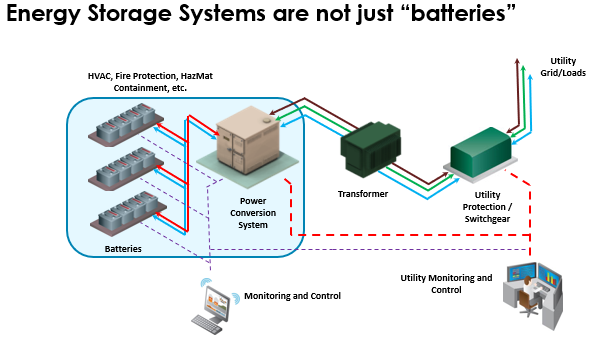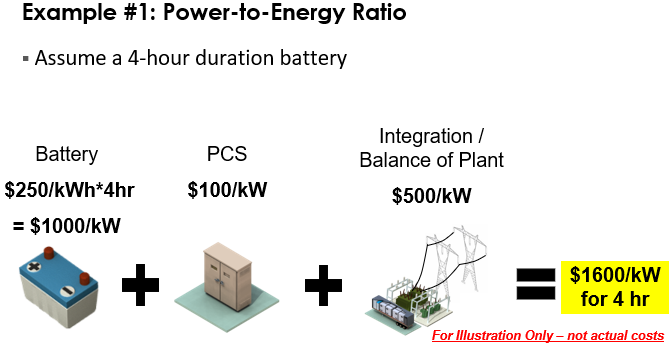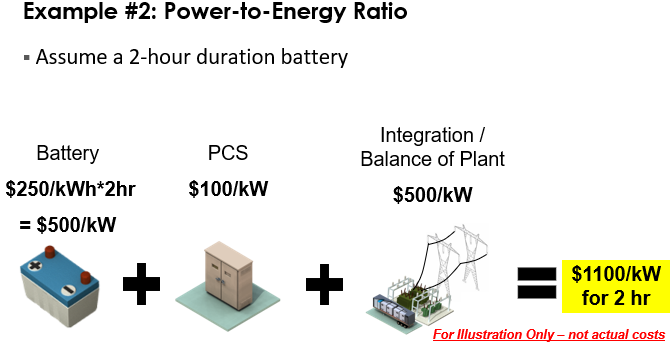Difference between revisions of "Energy Storage 101/Economics"
| Line 3: | Line 3: | ||
=Cost Components and Trends= | =Cost Components and Trends= | ||
Clarity on costs is a critical component of energy storage economics. That includes what is included in the scope of the cost and how costs are communicated. | Clarity on costs is a critical component of energy storage economics. That includes what is included in the scope of the cost and how costs are communicated. | ||
<br>[[File: | <br>[[File:Es101cost10.png]] | ||
<br>Other generation resource costs are often communicated on a $/kW basis, but energy storage has both power and energy components and the normalized cost will vary with duration. This is highlighted in two examples below. | <br>Other generation resource costs are often communicated on a $/kW basis, but energy storage has both power and energy components and the normalized cost will vary with duration. This is highlighted in two examples below. | ||
<br>[[File: | <br>[[File:Es101cost20.png]] | ||
<br> | <br> | ||
<br>[[File: | <br>[[File:Es101cost30.png]] | ||
=Grid Services and Uses= | =Grid Services and Uses= | ||
Revision as of 13:43, 27 October 2020
Cost Components and Trends
Clarity on costs is a critical component of energy storage economics. That includes what is included in the scope of the cost and how costs are communicated.

Other generation resource costs are often communicated on a $/kW basis, but energy storage has both power and energy components and the normalized cost will vary with duration. This is highlighted in two examples below.


Grid Services and Uses
Energy storage has many capabilities:
- Capacity Resource: Firm power
- Flexibility Resource: Fast response and ramping
- Backup Resource: Energy reserve
- Power Quality Resource: 4-quadrant watts and VARs
The table below list the grid services energy storage can support.
File:Es101app.png
Transmission-connected storage may provide:
- Generation capacity (resource adequacy)
- Black start
- Virtual transmission capacity
- Energy time-shifting
- Ancillary services
Distribution-connected storage may provide:
- Virtual distribution capacity
- Enhance power quality
- Resiliency / backup power / microgrid
- Upstream transmission impacts – either costs or benefits
Customer-connected storage may provide:
- Customer bill savings: Retail time-of-use tariff energy shifting, Demand charge management
- Backup power
- Upstream T&D impacts – either costs or benefits
Modeling Energy Storage
Challenges to modeling energy storage include:
- Storage is not yet a common grid asset
- Rules and regulations are still evolving
- Benefit stacking is appealing, but is it possible?
- More services = more value
- More services = more requirements
- Can these requirements be satisfied?
- Storage value analyses are site-specific
- Complex co-optimization between storage technologies, objectives, and constraints
Understanding Service Compatibility
- Energy Storage Services Hierarchy
- Energy storage services only flow from bottom up, customer storage may provide distribution and transmission-level services, but transmission storage can NOT provide distribution or customer services
- Reliability vs. Economic
- Reliability takes priority (e.g. T&D deferral higher priority than market services)
- Long-term planning constraints take priority to economic optimization and constraints roll-up; Multi-year >> Annual >> Monthly >> Day-ahead >> Real-time
- Local vs. System Level
- Local objectives generally supersede system objectives when there is a conflict (e.g. T&D deferral higher priority than resource adequacy) although should be designed so that reliability services never conflict
EPRI Tools to Support Valuation Modeling
StorageVET
DER-VET